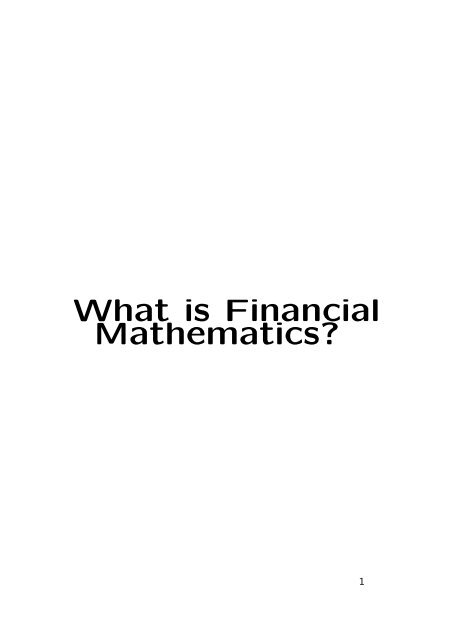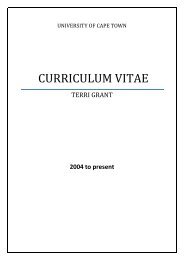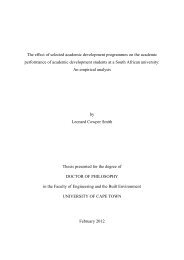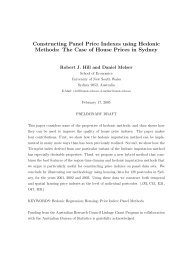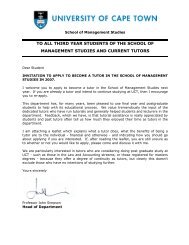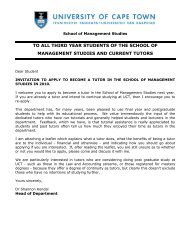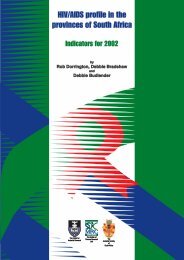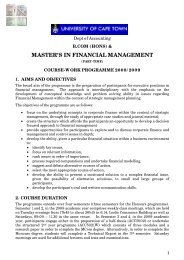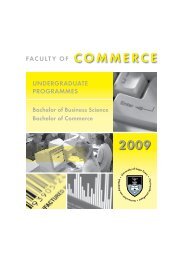What is Financial Mathematics?
What is Financial Mathematics?
What is Financial Mathematics?
Create successful ePaper yourself
Turn your PDF publications into a flip-book with our unique Google optimized e-Paper software.
<strong>What</strong> <strong>is</strong> <strong>Financial</strong><br />
<strong>Mathematics</strong>?<br />
1
Introduction<br />
• <strong>Financial</strong> <strong>Mathematics</strong> <strong>is</strong> a collection of<br />
mathematical techniques that find applications<br />
in finance, e.g.<br />
– Asset pricing: derivative securities.<br />
– Hedging and r<strong>is</strong>k management<br />
– Portfolio optimization<br />
– Structured products<br />
• There are two main approaches:<br />
– Partial Differential Equations<br />
– Probability and Stochastic Processes<br />
2
Short H<strong>is</strong>tory of <strong>Financial</strong> <strong>Mathematics</strong><br />
• 1900: Bachelier uses Brownian motion as<br />
underlying process to derive option prices.<br />
• 1973: Black and Scholes publ<strong>is</strong>h their<br />
PDE-based option pricing formula.<br />
• 1980: Harr<strong>is</strong>on and Kreps introduce the<br />
martingale approach into mathematical<br />
finance.<br />
• <strong>Financial</strong> <strong>Mathematics</strong> has been establ<strong>is</strong>hed<br />
as a separate academic d<strong>is</strong>cipline<br />
only since the late eighties, with a number<br />
of dedicated journals.<br />
3
Structure of th<strong>is</strong> talk<br />
• Preliminary notions: Time value of money,<br />
financial securities, options.<br />
• Arbitrage and r<strong>is</strong>k–neutral valuation<br />
via a one–period, two–state toy model.<br />
• Modelling stock price behaviour<br />
• Naive stochastic calculus<br />
• PDE approach to finance<br />
• Martingale approach to finance<br />
• Numerical methods<br />
• Current Research<br />
4
Preliminary Notions<br />
D<strong>is</strong>counting and <strong>Financial</strong> Instruments<br />
• Finance may be defined as the study of<br />
how people allocate scarce resources over<br />
time.<br />
• The outcomes of financial dec<strong>is</strong>ions (costs<br />
and benefits) are<br />
– spread over time<br />
– not generally known with certainty ahead<br />
of time, i.e. subject to an element of<br />
r<strong>is</strong>k<br />
• Dec<strong>is</strong>ion makers must therefore<br />
– be able to compare the values of cashflows<br />
at different dates<br />
– take a probabil<strong>is</strong>tic view<br />
5
D<strong>is</strong>counting<br />
• The time value of money: R1.00 in the<br />
hand today <strong>is</strong> worth more than the expectation<br />
of receiving R1.00 at some future<br />
date.<br />
• Thus borrowing <strong>is</strong>n’t free: the borrower<br />
pays a premium to induce the lender to<br />
part with h<strong>is</strong>/her money. Th<strong>is</strong> premium<br />
<strong>is</strong> the interest.<br />
• We shall make the simplifying assumptions<br />
that<br />
– There <strong>is</strong> only one interest rate: All<br />
investors can borrow and lend at th<strong>is</strong><br />
(r<strong>is</strong>kless) rate.<br />
– The interest rate <strong>is</strong> constant over time.<br />
– The same rate applies for all maturities.<br />
6
• Let r denote the continuously compounded<br />
interest rate, so that one unit of currency<br />
deposited in a (r<strong>is</strong>kless) bank account<br />
grows to e rT units in time T .<br />
• Thus an amount X at time T <strong>is</strong> the same<br />
as Xe −rT now.<br />
• D<strong>is</strong>counting allows us to compare amounts<br />
of money at different times.<br />
7
Returns<br />
• The return on an investment S <strong>is</strong> defined<br />
by<br />
R = ln S T<br />
S 0<br />
i.e. S T = S 0 e RT<br />
The random variable R <strong>is</strong> essentially the<br />
“interest” obtained on the investment,<br />
and may be negative.<br />
• Investors attempt to maximize their expected<br />
return.<br />
Fundamental relationship in finance:<br />
•<br />
E[Return] = f(R<strong>is</strong>k)<br />
where f <strong>is</strong> an increasing function.<br />
8
Securities<br />
• Securities are contracts for future delivery<br />
of goods or money, e.g. shares, bonds<br />
and derivatives.<br />
• One d<strong>is</strong>tingu<strong>is</strong>hes between underlying (primary)<br />
and derivative (secondary) instruments.<br />
• Examples of underlying instruments are<br />
shares, bonds, currencies, interest rates,<br />
and indices.<br />
• A derivative (or contingent claim) <strong>is</strong> a<br />
financial instruments whose value <strong>is</strong> derived<br />
from an underlying asset.<br />
• Examples of derivatives are forward contracts,<br />
futures, options, swaps and bonds.<br />
9
• There are two main reasons for using derivatives:<br />
Hedging and Speculation.<br />
• Thus derivatives are essentially tools for<br />
transferring r<strong>is</strong>k, and will allow one to<br />
dimin<strong>is</strong>h or increase one’s exposure to uncertain<br />
events.<br />
• An option gives the holder the right, but<br />
not the obligation to buy or sell an asset.<br />
• A European call option gives the holder<br />
the right to buy an asset S (the underlying)<br />
for an agreed amount K (the strike<br />
price) on a specified future date T (maturity).<br />
10
• Thus the payoff at expiry <strong>is</strong><br />
max{S(T ) − K, 0}<br />
• Since the payoff can never be negative,<br />
but <strong>is</strong> sometimes positive, options aren’t<br />
free. The premium paid for the option<br />
<strong>is</strong> related to the r<strong>is</strong>k (“probability”) that<br />
the share price <strong>is</strong> greater than the strike<br />
at expiry.<br />
11
R<strong>is</strong>k-Neutral Valuation<br />
• Consider a toy model with just two trading<br />
dates t = 0 and t = T , and just two<br />
financial assets<br />
– A r<strong>is</strong>k–free bank account A paying<br />
a constant simple rate r = 10% over<br />
the interval [0, T ].<br />
– A r<strong>is</strong>ky stock S. Today’s stock price<br />
<strong>is</strong> S 0 = 10.<br />
• At time T , there are only two possible<br />
states of the world, UP and DOWN.<br />
12
• We model th<strong>is</strong> using the tuple<br />
(Ω, P, F, T, F, (A t , S t ) t∈T )<br />
• Here Ω = {Up, Down}, and P <strong>is</strong> a probability<br />
measure on Ω.<br />
13
• Consider a European call option on S<br />
with strike price K = 11 and maturity<br />
T . At maturity the call option has the<br />
following possible values:<br />
• How would we find “the” fair price C 0<br />
for th<strong>is</strong> contract at t = 0?<br />
14
• Two possibilities come to mind:<br />
– METHOD I. Calculate the expected<br />
value of the future payoff, and d<strong>is</strong>count<br />
th<strong>is</strong> to the present.<br />
Thus<br />
C 0 = 1 [P(UP) · 11 + P(Down) · 0]<br />
1.1<br />
= 10 · P(UP)<br />
∗ PROBLEM: How do we determine<br />
the measure P?<br />
If we consider both states equally<br />
likely, the value of the call option<br />
will be C(0) = 5<br />
– METHOD II. The price of the option<br />
will be determined by the market, in<br />
particular by supply and demand.<br />
15
• The correct price can be determined by<br />
an arbitrage argument, as follows:<br />
• Consider a portfolio θ = (θ 0 , θ 1 ) containing<br />
an amount θ 0 in the bank and a quantity<br />
θ 1 shares. The initial value of the<br />
portfolio <strong>is</strong> V 0 (θ) = θ 0 + 10θ 1 .<br />
• We want to ensure that the portfolio has<br />
the same value as the call option in all<br />
states of the world at expiry.<br />
UP V T (θ) = 1.1θ 0 + 22θ 1 = 11<br />
DOWN V T (θ) = 1.1θ 0 + 5.5θ 1 = 0<br />
i.e.<br />
θ =<br />
(<br />
− 10 3 , 2 )<br />
3<br />
• Thus if you borrow 10<br />
3 and buy 2 3 shares,<br />
the resulting portfolio has the same cashflows<br />
at maturity as the call option.<br />
17
• To exclude arbitrage, the initial value<br />
of the option must be the same as the<br />
initial value of the portfolio, i.e.<br />
C(0) = − 10 3 + 10 · 2<br />
3 = 10 3<br />
• Arbitrage <strong>is</strong> the possibility of making a<br />
profit without the possibility of making a<br />
loss.<br />
• In the preceding example, if the option<br />
costs less than the portfolio, then<br />
– Short the portfolio;<br />
– Use the proceeds to buy the option;<br />
– And put the remainder in the bank.<br />
18
• Note that the option price using d<strong>is</strong>counted<br />
expected values was 5, which <strong>is</strong> higher<br />
than 10/3. How can th<strong>is</strong> be?<br />
• If we ins<strong>is</strong>t on using the probability measure<br />
P, then the share itself <strong>is</strong> priced “incorrectly”.<br />
– Its value ought to have been<br />
S 0 = 1 [ 1<br />
1.1 2 (22) + 1 ]<br />
2 (5.5) = 12.5<br />
– but the real price <strong>is</strong> S 0 = 10.<br />
19
• Th<strong>is</strong> reflects the fact that investors are<br />
r<strong>is</strong>k averse. In order to take on the r<strong>is</strong>k<br />
of the share, investors require a r<strong>is</strong>k premium<br />
Rp:<br />
1<br />
10 = S 0 =<br />
1 + r + Rp E P [S T ]<br />
1<br />
=<br />
1.1 + Rp [1 2 · 22 + 1 2 · 5.5]<br />
• Suppose that we now change the probability<br />
measure to a new measure Q under<br />
which investors are r<strong>is</strong>k–neutral, i.e.<br />
under which they do not require a r<strong>is</strong>k<br />
premium.<br />
• In th<strong>is</strong> world, the current value of the<br />
share <strong>is</strong> its d<strong>is</strong>counted expected value.<br />
10 = 1 [Q(UP) · 22 + (1 − Q(UP)) · 5.5]<br />
1.1<br />
which implies that Q(UP) = 1 3 ,<br />
and Q(DOWN) = 2 3 . 20
• If we price the option using the d<strong>is</strong>counted<br />
expected value under the r<strong>is</strong>k–neutral measure<br />
Q, we get<br />
C(0) = 1<br />
1.1 (1 3 · 11 + 2 3 · 0) = 10 3<br />
• and th<strong>is</strong> <strong>is</strong> CORRECT!!!<br />
Principle of R<strong>is</strong>k–Neutral Valuation:<br />
– The t = 0–value of an option <strong>is</strong> its<br />
d<strong>is</strong>counted expected value.<br />
– However, the expectation <strong>is</strong> taken under<br />
a r<strong>is</strong>k–neutral probability mea-<br />
•<br />
sure, which we can calculate.<br />
– And not under the “real–world” probability<br />
measure, which we can never<br />
know.<br />
21
Modelling Stock Prices<br />
• Any model of stock price behaviour must<br />
be stochastic, i.e. incorporate the random<br />
nature of price behaviour. The simplest<br />
such models are random walks.<br />
• Partition the interval [0, T ] into subintervals<br />
of length ∆t<br />
0 = t 0 ≤ t 1 ≤ · · · ≤ t N = T N = T ∆t<br />
• Let X tn , n = 1, 2, . . . N be a family of random<br />
variables, and let S 0 be the stock<br />
price at t = 0.<br />
We might (naively) attempt<br />
to model the stock price process<br />
by<br />
S tn+1 = S tn + X tn+1<br />
22
• Thus<br />
S t = S 0 +<br />
t∑<br />
X u<br />
u=1<br />
• The intuition behind th<strong>is</strong> <strong>is</strong> that the price<br />
at time t + ∆t equals the price at time t<br />
plus a “random shock”, modelled by X t .<br />
• We also assume that these shocks are<br />
independent.<br />
• Efficient Markets Hypothes<strong>is</strong>: Stock<br />
price processes are Markov processes.<br />
23
• Fact: If X n are independent random variables,<br />
then<br />
var( ∑ n X n) = ∑ n var(X n)<br />
• Thus if the X n are independent, identically<br />
d<strong>is</strong>tributed, then the variance of<br />
the sum <strong>is</strong> proportional to the number of<br />
terms.<br />
• So the variance of the stock price in our<br />
naive random walk model <strong>is</strong> proportional<br />
to the elapsed time.<br />
24
• We attempt to build a continuous–time<br />
model of stock price behaviour over an<br />
interval [0, T ]. As a first approximation,<br />
we use Bernoulli shocks every unit time,<br />
i.e. we let<br />
{<br />
+∆S with probability 0.5<br />
X t =<br />
−∆S with probability 0.5<br />
• Note that<br />
Var(X t ) = ∆S 2<br />
Var(S T ) =<br />
N∑<br />
n=1<br />
= N∆S 2<br />
Var(X tn )<br />
= ∆S2<br />
∆t T 25
• How large should the jumps in stock price<br />
be? To ensure that Var(S T ) goes to neither<br />
0 nor ∞ as ∆t → 0, we must have<br />
∆S = o( √ ∆t)<br />
• Note that for differentiable functions f(t),<br />
we have ∆f ≈ f ′ (t)∆t, i.e.<br />
∆f = o(∆t)<br />
• Th<strong>is</strong> shows that S t cannot be differentiable!<br />
26
• To build a continuous version of our model,<br />
we use the Central Limit Theorem: If<br />
X n <strong>is</strong> a larg<strong>is</strong>h family of iid random variables,<br />
then ∑ n X n <strong>is</strong> approximately normally<br />
d<strong>is</strong>tributed.<br />
• Thus: After a larg<strong>is</strong>h number of shocks,<br />
the stock price in our naive random walk<br />
model will be approximately normally d<strong>is</strong>tributed.<br />
• We seek a continuous-time version of the<br />
random walk — a stochastic process that<br />
<strong>is</strong> changing because of random shocks at<br />
every instant in time.<br />
27
Brownian motion<br />
• Brownian motion <strong>is</strong> a continuous–time<br />
stochastic process B t , t ≥ 0 with the following<br />
properties:<br />
(1) Each change<br />
B t − B s = (B s+h − B s ) + (B s+2h − B s+h )<br />
+ · · · + (B t − B t−h )<br />
<strong>is</strong> normally d<strong>is</strong>tributed with mean 0<br />
and variance t − s.<br />
(2) Each change B t − B s <strong>is</strong> independent<br />
of all the previous values B u , u ≤ s.<br />
(3) Each sample path B t , t ≥ 0 <strong>is</strong> (a.s.)<br />
continuous, and has B 0 = 0.<br />
• Brownian motion <strong>is</strong> a martingale:<br />
E s B t = B s<br />
s ≤ t<br />
where E s denotes the expectation at time<br />
s.<br />
28
GBM<br />
• For stock prices, the Brownian motion<br />
model <strong>is</strong> inadequate. We expect the change<br />
in price to be proportional to the current<br />
price.<br />
• A better model for share prices <strong>is</strong> given<br />
by the stochastic differential equation<br />
dS t = µS t dt + σS t dB t<br />
• Here µ <strong>is</strong> the drift, i.e. the rate at which<br />
the share price increases in the absence<br />
of r<strong>is</strong>k. The differential dB t models the<br />
randomness (r<strong>is</strong>k), and the parameter σ,<br />
known as the volatility, models how sensitive<br />
the share price <strong>is</strong> to these random<br />
events.<br />
• Th<strong>is</strong> share price process <strong>is</strong> called a geometric<br />
Brownian motion.<br />
29
Value process<br />
• Consider a market with a share S t whose<br />
price process <strong>is</strong> a GBM<br />
dS t = µS t dt + σS t dB t<br />
• Let the r<strong>is</strong>k–free interest rate be r, i.e.<br />
the r<strong>is</strong>k–free bank account A t sat<strong>is</strong>fies<br />
the DE<br />
dA t = rA t dt<br />
A t <strong>is</strong> the r<strong>is</strong>kless asset. It has drift r<br />
and zero volatility.<br />
• Given a dynamic portfolio θ t = (θ 0 t , θ1 t ),<br />
the value process V t (θ) <strong>is</strong> defined by<br />
V t (θ) = θ 0 t A t + θ 1 t S t<br />
• It sat<strong>is</strong>fies the SDE<br />
dV t = θ 0 t dA t + θ 1 t dS t<br />
= (rθ 0 t A t + µθ 1 t S t) dt + θ 1 σS t dB t<br />
30
• The value of the portfolio at time T <strong>is</strong><br />
therefore<br />
V T (θ) = V 0 (θ) +<br />
+<br />
∫ T<br />
0<br />
∫ T<br />
0<br />
[rθ 0 t A t + µθ 1 t S t ] dt<br />
θ 1 σS t dB t<br />
• We now see that we need to be able to<br />
evaluate integrals of the form<br />
∫ T<br />
0<br />
f(t, ω) dB t (ω)<br />
• The obvious method would be to regard<br />
the above as a Riemann–Stieltjes (or<br />
Lebesgue–Stieltjes) integral.<br />
31
Stochastic Calculus<br />
Naive Approach<br />
• Let f(x) be a differentiable function on<br />
an interval [a, b]. Partition th<strong>is</strong> interval:<br />
a = x 0 < x 1 < x 2 < x n = b<br />
where x i+1 − x i = ∆x<br />
• Then by Taylor series expansion, we get<br />
f(x i+1 ) − f(x i ) = f ′ (x i )∆x + 1 2! f ′′ (x i )(∆x) 2<br />
+ 1 3! f ′′′ (x i )(∆x) 3 + terms involving ∆x 4 , ∆x 5 , . . .<br />
• Thus<br />
f(b) − f(a) =<br />
=<br />
n−1<br />
∑<br />
i=0<br />
n−1<br />
[f(x i+1 ) − f(x i )]<br />
∑<br />
f ′ (x i )∆x + 1 2<br />
i=0<br />
n−1<br />
∑<br />
i=0<br />
f ′′ (x i )(∆x) 2 + . . .<br />
32
• As ∆x → 0, we get<br />
f(b) − f(a) = lim<br />
∆x→0<br />
+ 1 2 lim<br />
∆x→0<br />
=<br />
∫ b<br />
a<br />
∑<br />
f ′ (x i )∆x<br />
i<br />
∑<br />
f ′′ (x i )(∆x) 2 + . . .<br />
i<br />
[ ∫ 1 b<br />
]<br />
f ′ (x) dx + f ′′ (x) (dx) 2 + . . .<br />
2<br />
a<br />
• In ordinary calculus, only the first term<br />
counts (by the Fundamental Theorem of<br />
Calculus), and the other terms are zero.<br />
• Th<strong>is</strong> <strong>is</strong> because the quadratic variation<br />
of any “ordinary” function <strong>is</strong> zero, i.e.<br />
lim<br />
∆x→0<br />
∑<br />
(∆g) 2 = 0<br />
for any “ordinary” function g.<br />
33
• But Brownian motion <strong>is</strong> different: Consider<br />
∆B = B t+∆t − B t . Th<strong>is</strong> <strong>is</strong> a normally<br />
d<strong>is</strong>tributed random variable with E[∆B] =<br />
0 and variance var(∆B) = ∆t.<br />
• Consider next the random variable (∆B) 2 .<br />
Th<strong>is</strong> has<br />
E[(∆B) 2 ] = var[∆B] = ∆t<br />
var[(∆B) 2 ] = E[(∆B) 4 ] − (∆t) 2 = 2(∆t) 2
• Also<br />
lim<br />
∆t→0<br />
∑<br />
E(∆B) 4 = 2 lim<br />
∆t→0<br />
∑<br />
(∆t) 2 = 0<br />
because g(t) = t <strong>is</strong> an “ordinary” function,<br />
with quadratic variation zero.<br />
• Hence we cannot ignore the second–order<br />
term<br />
1<br />
2<br />
∫ b<br />
a<br />
f ′′ (x) (dx) 2<br />
in the case that x = B.<br />
• But we can ignore all higher–order terms.<br />
• We thus have the following rules for stochastic<br />
calculus:<br />
(dB t ) 2 = dt<br />
dB t · dt = (dt) 2 = 0<br />
35
• Suppose that f(t, x) <strong>is</strong> a C 1,2 –function,<br />
and let X t = f(t, B t ). Applying these<br />
rules to a second order Taylor series, we<br />
obtain:<br />
Theorem: (Ito’s Formula)<br />
dX t =<br />
(<br />
∂f<br />
∂t + 1 ∂ 2 )<br />
f<br />
2∂B 2<br />
dt + ∂f<br />
∂B dB t<br />
• Ordinary calculus shows that for a function<br />
f(t, x) we have<br />
df = ∂f<br />
∂t<br />
dt +<br />
∂f<br />
∂x dx<br />
• In stochastic calculus, we get another term,<br />
due to the non–zero quadratic variation<br />
of Brownian motion.<br />
36
• Since Brownian motion has non-zero quadratic<br />
variation, Brownian sample paths are (a.s.)<br />
of unbounded variation.<br />
• Th<strong>is</strong> means that in general the Ito stochastic<br />
integral ∫ T<br />
0 f dB t cannot be interpreted<br />
as a Riemann–Stieltjes integral.<br />
• Nevertheless, the stochastic integral can<br />
be defined with semimartingale integrators<br />
(using an approximation in a L 2 –<br />
space, rather than an (almost) pointw<strong>is</strong>e<br />
limit).<br />
• Fact: The Ito integral<br />
M t =<br />
∫ t<br />
0<br />
f(u, B u ) dB u<br />
<strong>is</strong> a (local) martingale, i.e.<br />
[∫ t<br />
]<br />
E s f dB u =<br />
0<br />
∫ s<br />
0<br />
f dB u<br />
37
Stock price process parameters<br />
• Let’s have another look at volatility. The<br />
GBM model for stock prices <strong>is</strong><br />
Thus<br />
dS t = µS t dt + σS t dB t<br />
[ dS<br />
E<br />
S<br />
] 2<br />
= σ 2 dt<br />
and thus σ 2 dt <strong>is</strong> the variance of the return<br />
of the stock over a small period dt.<br />
• It follows that σ <strong>is</strong> the standard deviation<br />
of the annual return of the stock<br />
S.<br />
• Th<strong>is</strong> can be measured from market data.<br />
38
• Can we also measure the drift µ?<br />
No.<br />
• So the correct, real-world dynamics of a<br />
share price are unknowable: We can get<br />
the volatility, but not the drift.<br />
• Amazingly, we don’t care!!<br />
39
Black-Scholes Model<br />
PDE Approach<br />
• Consider again market with a share S t<br />
whose price process sat<strong>is</strong>fies the SDE<br />
dS t = µS t dt + σS t dB t<br />
• Let the r<strong>is</strong>k–free interest rate be r, and<br />
let A t be the r<strong>is</strong>kless bank account, with<br />
dynamics<br />
dA t = rA t dt<br />
• Let V (t, S t ) be European–style derivative<br />
whose value depends on both the share<br />
price and time. Consider a portfolio Π<br />
which contains 1 derivative, and n shares,<br />
i.e. its value <strong>is</strong><br />
Π t = V t + nS t<br />
40
• A small amount of time dt later, the share<br />
price has changed. The value of the portfolio<br />
changes by<br />
dΠ t = dV t + n dS t<br />
• By Ito’s Formula,<br />
dV t = ∂V ∂V<br />
dt +<br />
∂t ∂S dS + 1 ∂ 2 V<br />
2 ∂S 2 dS2<br />
( ∂V ∂V<br />
= + µS<br />
∂t ∂S + 1 2 σ2 S 2 ∂V )<br />
∂S 2<br />
dt + σS ∂V<br />
∂S dB t<br />
• Hence<br />
( ∂V ∂V<br />
dΠ t = + µS<br />
∂t ∂S + 1 2 σ2 S 2 ∂V )<br />
∂S + nµS ( )<br />
2<br />
∂V<br />
+ σS<br />
∂S + n<br />
dt<br />
dB t<br />
41
• Now if we take n = − ∂V<br />
∂S<br />
(i.e. the portfolio<br />
<strong>is</strong> short − ∂V<br />
∂S<br />
shares), then the portfolio<br />
<strong>is</strong> unaffected by a random change<br />
in the stock price:<br />
dΠ t =<br />
( ∂V<br />
∂t + 1 2 σ2 S 2 ∂V<br />
∂S 2 )<br />
dt (1)<br />
• Thus, for a brief instant, the portfolio<br />
<strong>is</strong> r<strong>is</strong>k–free. By a no–arbitrage argument,<br />
it must earn the same return as<br />
the r<strong>is</strong>k–free bank account, i.e.<br />
dΠ t = rΠ t dt = r<br />
(<br />
V − ∂V<br />
∂S S )<br />
dt (2)<br />
42
• Equating (1) and (2), we get<br />
∂V<br />
∂t + 1 2 σ2 S 2∂2 V<br />
∂S 2 + rS∂V ∂S − rV = 0<br />
• Th<strong>is</strong> <strong>is</strong> the famous Black–Scholes PDE.<br />
It <strong>is</strong> a second–order parabolic PDE, i.e.<br />
essentially a heat equation.<br />
• It <strong>is</strong> now clear why we don’t care about<br />
the drift µ of the underlying asset S: It<br />
does not appear in the BS PDE!!<br />
43
Black–Scholes Model<br />
R<strong>is</strong>k–Neutral Approach<br />
• Since we don’t care about the drift rate<br />
µ of an underlying asset, we may as well<br />
simplify our asset price dynamics by assuming<br />
that all assets have the same<br />
drift.<br />
• The r<strong>is</strong>kless asset (bank account) has drift<br />
r, which we can actually see. We thus<br />
assume that all assets have the same return,<br />
namely the r<strong>is</strong>k–free rate r.<br />
• Mathematically, th<strong>is</strong> corresponds to a change<br />
of measure — from a real world, unknowable<br />
probability measure P to a knowable,<br />
r<strong>is</strong>k–neutral measure Q. In the<br />
r<strong>is</strong>k–neutral world, the dynamics of S are<br />
dS t = rS t dt + σS dB t<br />
Thus we change the drift of the asset<br />
from µ to r.<br />
44
• Mathematically, th<strong>is</strong> <strong>is</strong> accompl<strong>is</strong>hed using<br />
the Cameron–Girsanov Theorem:<br />
Let<br />
dY t = µ(t, ω) dt + θ(t, ω) dB t<br />
be an Ito process in a filtered probability<br />
space (Ω, F t , P) Suppose that there ex<strong>is</strong>ts<br />
processes u(t, ω) and ν(t, ω) such that<br />
θ · u = ν − µ<br />
Define a process M by<br />
∫ t<br />
∫ t<br />
M t = exp( u dB s − 1<br />
0 2 0 ||u||2 ds)<br />
and define a measure Q by<br />
dQ<br />
dP = M T<br />
Then under Q, Y –dynamics are<br />
dY t = ν(t, ω) dt + θ(t, ω) d ˆB t<br />
where ˆB t <strong>is</strong> a Q–Brownian motion.<br />
• Amazingly, a change of measure changes<br />
only the drift and not the volatility.<br />
45
• We can calculate option prices in the r<strong>is</strong>k–<br />
neutral world, because the asset price<br />
dynamics/d<strong>is</strong>tributions are known.<br />
• But: Prices in the real– and r<strong>is</strong>k–neutral<br />
world are the same! It <strong>is</strong> just probabilities<br />
that are changed.<br />
Fundamental Theorem of Asset Pricing:<br />
There are no arbitrage opportunities<br />
•<br />
if and only if there ex<strong>is</strong>ts a r<strong>is</strong>k–neutral<br />
measure.<br />
46
PDE = R<strong>is</strong>k–Neutral<br />
• Consider a European call option C on a<br />
share S with strike K and maturity T .<br />
The volatility of the underlying share S <strong>is</strong><br />
σ and the r<strong>is</strong>k–free rate <strong>is</strong> r.<br />
• We must solve the following BVP:<br />
⎧<br />
⎨ ∂V<br />
∂t + 1 2 σ2 S 2∂2 V ∂V<br />
+ rS<br />
∂S2 ∂S − rV = 0<br />
⎩<br />
V (T ) = Φ(S T ) = max{S T − K, 0}<br />
• Theorem: In the r<strong>is</strong>k–neutral world, the<br />
d<strong>is</strong>counted value process V t<br />
A<br />
= e −rt V t t <strong>is</strong><br />
a martingale:<br />
e −rT V T = V 0 +<br />
∫ T<br />
0<br />
e −rt σS t dB t<br />
47
• It follows that the expected value of<br />
e −rt V t at any time <strong>is</strong> its current value,<br />
and thus the value of the call option with<br />
strike K and maturity T <strong>is</strong> given by<br />
V 0 = E 0 [e −rT V T ] = e −rT E 0 [max{S T − K, 0}]<br />
• In the same way, the value of any European–<br />
style contingent claim V with maturity T<br />
and payoff (boundary condition) V (T, S T ) =<br />
Φ(S T ) <strong>is</strong> simply<br />
V 0 = e −rT E[Φ(S T )]<br />
• Th<strong>is</strong> <strong>is</strong> a version of the Feynman–Kac<br />
Theorem, which gives the solution to a<br />
large class of parabolic PDE’s as an expectation<br />
of a diffusion (here with loss of<br />
mass, represented by d<strong>is</strong>counting).<br />
48
Computational Toolbox<br />
• Numerical integration<br />
• Optimization techniques<br />
• Finite difference methods<br />
• Lattice/tree methods<br />
• Monte Carlo and quasi–Monte Carlo methods<br />
• Stat<strong>is</strong>tical techniques: Principal component<br />
analys<strong>is</strong>, factor analys<strong>is</strong>, maximum<br />
entropy<br />
49
• Time series analys<strong>is</strong><br />
• Numerical solution of SDE’s<br />
• Dynamic programming<br />
• Stochastic control theory<br />
50
Current Research<br />
• Altenatives to Black–Scholes<br />
– Stochastic volatility models.<br />
– Jump diffusions.<br />
– Levy processes.<br />
• Interest–rate modelling.<br />
• Pricing in incomplete markets.<br />
• Pricing/measuring/hedging credit r<strong>is</strong>k.<br />
51
• Capital adequacy based r<strong>is</strong>k measures<br />
• Real options<br />
• Differential game theory<br />
• Entropy–based option pricing<br />
• Viability theory<br />
• Non-standard finance<br />
52


